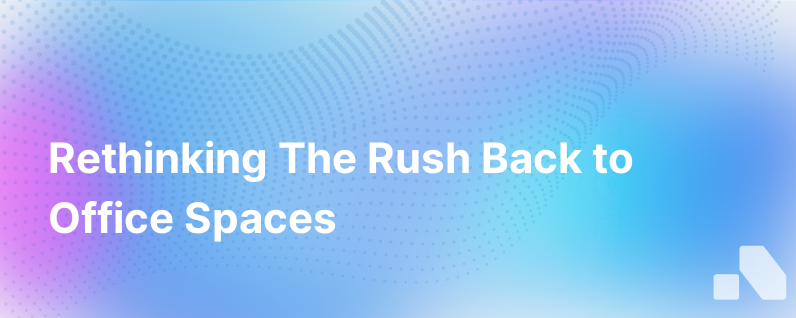
In recent times, a seismic shift has occurred in the corporate world. As COVID-19 pressures wane and vaccination rates rise, companies are reopening offices and debating the merits of in-person work. Despite the push to return to office-centric routines, the chorus of voices declaring this model overrated is growing louder. In this piece, we will explore the multifaceted arguments for why returning to the office may indeed be overrated and consider what alternative models can offer.
The Allure of the Office: A Reassessment
The office has long been the crucible of professional identity—where serendipitous encounters foster innovation and hierarchical structures thrive. Yet the pandemic has dispelled the myth that it is the solitary space where productivity and collaboration flourish.
During the global work-from-home experiment, many employees discovered profound benefits: flexibility, no commute, and work-life balance. A Stanford study found a productivity boost among remote workers equivalent to a full day's work. These findings beg the question, with outcomes like these, is returning to the traditional office setting necessary, or even beneficial?
Re-evaluating the Commute
The daily commute stands as one of the prime reasons for the diminishing appeal of office-centric work. Hours once spent in the claustrophobia of traffic or the confines of public transportation were suddenly available for personal enrichment or additional sleep. The environmental impact cannot be understated, either. Reduced commuter travel has led to a noticeable decrease in carbon emissions, fostering a dialogue on the ecological responsibility of corporations in a post-pandemic world.
Work-Life Balance and Flexibility
Arguably, work-life balance has been the Holy Grail of the modern workforce; the pandemic inadvertently showed that it is attainable. Remote work has allowed professionals to manage their time in unprecedented ways, integrating work and life without the strict boundaries of office hours. Parents have been able to spend more time with their children, while others have cared for sick relatives, pursued hobbies, or invested in personal development—all of which contribute to employee wellness and, by extension, productivity.
The Myth of Productivity in Physical Spaces
One strong argument that fortified pre-pandemic office culture was the belief that physical presence equated to enhanced productivity. However, the past months have debunked this notion. A WorkAnalytics study at IT services giant SAP suggested remote workers were not only sustaining but also increasing productivity.
Challenges of a Disconnected Workforce
Nevertheless, there are caveats to a wholesale endorsement of remote work. Isolation and loneliness have emerged as significant downsides for some, leading to discussions around mental health. Networking opportunities and mentoring relationships, often easier to cultivate in person, have faced hurdles. Additionally, the blurring lines between home and work have sometimes led to longer working hours and burnout.
The Hybrid Work Model: Finding a Middle Ground
Confronted with both positive and negative feedback, many companies are now considering a hybrid model. This approach combines the flexibility of remote work with the social interaction and collaborative potential of office life. A Global Workplace Analytics survey of Fortune 500 executives found that post-pandemic, 90% expect to adopt a hybrid work strategy. By embracing such a model, businesses can harness the enhanced employee satisfaction from remote work flexibility while still maintaining the option of face-to-face collaboration when needed.
The Rise of the Digital Workplace
Digital collaboration tools such as Zoom, Slack, and Google Workspace have soared in popularity, offering a patchwork digital simulation of the in-person office environment. These tools have not only bridged gaps but also leveled the playing field, allowing for a democratization of discussions, where the quietest voices can now 'speak' through chat and direct messages.
Company Culture in a Remote World
A key argument for returning to physical offices involves maintaining company culture. Counterintuitively, remote work may preserve it. Without the structure of office hierarchies and cliques, companies can reframe their culture around values, outcomes, and shared virtual experiences. Office perks are being reimagined too—instead of ping-pong tables and bean bags, employers are recognizing the value of mental health days, home office stipends, and online team-building activities.
Concluding Thoughts on the Office Return
The pandemic has liberated work from the constraints of location, revealing the office to be but one vessel for professional collaboration, not the indispensable hub it was once thought to be. Leaders are acknowledging that attention should be on the work produced, not where it's completed.
One does not have to look far to see the business giants setting the pace. Twitter, Spotify, and Salesforce are among those who have shifted to allow for more flexible working arrangements.
Final Perspective
The near future of work may likely see the traditional office as simply another tool in a varied arsenal rather than the command center of business operations. For both businesses and their employees, this could be a catalyst for a new work paradigm defined by autonomy, innovation, and balance. For every voice advocating for a return to the office, there is another extolling the virtues of a future unbound by office walls—suggesting that, perhaps, the era of the office as we know it is overrated and on the verge of transformation.